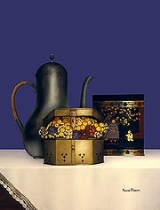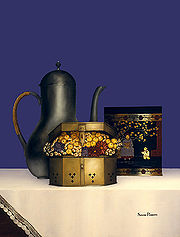
Susan Powers
Encyclopedia
Susan Powers is a self-taught American artist
who began painting in 1979, encouraged by a friend and fellow painter who had seen her expressive pencil drawings. Only a year later, her work had been accepted for display by the prestigious Jay Johnson
Folk Heritage Gallery in New York City
. In 1980, Powers spent a year in England
and France
developing her craft, before returning to the U.S.
The folk art
still lifes of Susan Powers have been compared with the trompe l'oeil
works of the well-known 19th–century American academic artist William Harnett
. Like Harnett, Powers is fascinated with common everyday objects — books, seashells, bottles, and teapots — and she renders them in a manner so lifelike they ‘fool the eye’ of the viewer, almost leading the viewer to believe that the objects themselves are present on the canvas. The trompe l’oeil technique is uncommon with folk artists: some folk artists cannot produce a photograph–like image.
Her paintings are in many permanent collections, including the Smithsonian Institution
in Washington, D.C.
and the American Museum
in Bath, England. Her works have been exhibited in numerous museums, including the Bede Gallery, Jarrow, England, the Woodspring Museum, Weston-super-Mare
, England, the Camden Arts Center, London, the Haworth Art Gallery, London, and at the White House
in Washington, D.C.
Ms. Powers attended the University of Vermont
, where she studied classical languages and medieval history, graduating in 1976 with a Bachelor of Arts degree in European Studies. She lives in Westchester County, New York, with her husband and daughter and their too many cats and dogs.

American Folk Art of the Twentieth Century
Jay Johnson & William C. Ketchum, Jr.
(Rizzoli International, New York, NY 1983)
Artist
An artist is a person engaged in one or more of any of a broad spectrum of activities related to creating art, practicing the arts and/or demonstrating an art. The common usage in both everyday speech and academic discourse is a practitioner in the visual arts only...
who began painting in 1979, encouraged by a friend and fellow painter who had seen her expressive pencil drawings. Only a year later, her work had been accepted for display by the prestigious Jay Johnson
Jay Johnson
Jay Johnson may refer to:* Jay W. Johnson * Jay W. Johnson, U.S. Democratic congressman from Wisconsin and Director of the United States Mint* Jay Johnson Detroit doo-wop bass-baritone singer* Jay L. Johnson, U.S...
Folk Heritage Gallery in New York City
New York City
New York is the most populous city in the United States and the center of the New York Metropolitan Area, one of the most populous metropolitan areas in the world. New York exerts a significant impact upon global commerce, finance, media, art, fashion, research, technology, education, and...
. In 1980, Powers spent a year in England
England
England is a country that is part of the United Kingdom. It shares land borders with Scotland to the north and Wales to the west; the Irish Sea is to the north west, the Celtic Sea to the south west, with the North Sea to the east and the English Channel to the south separating it from continental...
and France
France
The French Republic , The French Republic , The French Republic , (commonly known as France , is a unitary semi-presidential republic in Western Europe with several overseas territories and islands located on other continents and in the Indian, Pacific, and Atlantic oceans. Metropolitan France...
developing her craft, before returning to the U.S.
The folk art
Folk art
Folk art encompasses art produced from an indigenous culture or by peasants or other laboring tradespeople. In contrast to fine art, folk art is primarily utilitarian and decorative rather than purely aesthetic....
still lifes of Susan Powers have been compared with the trompe l'oeil
Trompe l'oeil
Trompe-l'œil, which can also be spelled without the hyphen in English as trompe l'oeil, is an art technique involving extremely realistic imagery in order to create the optical illusion that the depicted objects appear in three dimensions.-History in painting:Although the phrase has its origin in...
works of the well-known 19th–century American academic artist William Harnett
William Harnett
William Michael Harnett was an Irish-American painter known for his trompe l'oeil still lifes of ordinary objects.-Early life:...
. Like Harnett, Powers is fascinated with common everyday objects — books, seashells, bottles, and teapots — and she renders them in a manner so lifelike they ‘fool the eye’ of the viewer, almost leading the viewer to believe that the objects themselves are present on the canvas. The trompe l’oeil technique is uncommon with folk artists: some folk artists cannot produce a photograph–like image.
Her paintings are in many permanent collections, including the Smithsonian Institution
Smithsonian Institution
The Smithsonian Institution is an educational and research institute and associated museum complex, administered and funded by the government of the United States and by funds from its endowment, contributions, and profits from its retail operations, concessions, licensing activities, and magazines...
in Washington, D.C.
Washington, D.C.
Washington, D.C., formally the District of Columbia and commonly referred to as Washington, "the District", or simply D.C., is the capital of the United States. On July 16, 1790, the United States Congress approved the creation of a permanent national capital as permitted by the U.S. Constitution....
and the American Museum
American Museum
The American Museum in Britain is based at Claverton Manor, near Bath, England, in a house, designed by Jeffry Wyatville and built in the 1820s on the site of a manor bought by Ralph Allen in 1758...
in Bath, England. Her works have been exhibited in numerous museums, including the Bede Gallery, Jarrow, England, the Woodspring Museum, Weston-super-Mare
Weston-super-Mare
Weston-super-Mare is a seaside resort, town and civil parish in the unitary authority of North Somerset, which is within the ceremonial county of Somerset, England. It is located on the Bristol Channel coast, south west of Bristol, spanning the coast between the bounding high ground of Worlebury...
, England, the Camden Arts Center, London, the Haworth Art Gallery, London, and at the White House
White House
The White House is the official residence and principal workplace of the president of the United States. Located at 1600 Pennsylvania Avenue NW in Washington, D.C., the house was designed by Irish-born James Hoban, and built between 1792 and 1800 of white-painted Aquia sandstone in the Neoclassical...
in Washington, D.C.
Ms. Powers attended the University of Vermont
University of Vermont
The University of Vermont comprises seven undergraduate schools, an honors college, a graduate college, and a college of medicine. The Honors College does not offer its own degrees; students in the Honors College concurrently enroll in one of the university's seven undergraduate colleges or...
, where she studied classical languages and medieval history, graduating in 1976 with a Bachelor of Arts degree in European Studies. She lives in Westchester County, New York, with her husband and daughter and their too many cats and dogs.
Artwork

” The still lifes of Susan Powers have been compared
with the trompe l’oeil works of the well-known 19th–century
American academic artist William Harnett. Like Harnett,
Powers is fascinated with common everyday objects —
books seashells, bottles, and teapots — and she
renders them in a manner so lifelike they ‘fool the eye’
of the viewer, almost leading the viewer to believe that the
objects themselves are present on the canvas. The
trompe l’oeil technique is uncommon with folk artists:
some folk artists cannot produce a photograph–like image...”
American Folk Art of the Twentieth Century
Jay Johnson & William C. Ketchum, Jr.
(Rizzoli International, New York, NY 1983)

